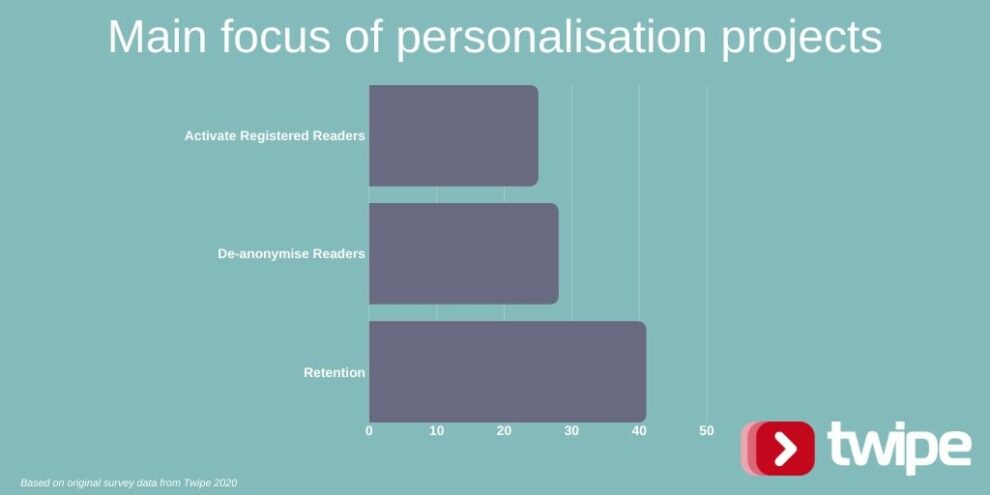Blog
How news publishers view personalisation in the age of reader disloyalty
As we are investing more and more into news personalisation technology at Twipe, this week we welcomed publishers from 22 countries to a webinar on personalisation and JAMES, Your Digital Butler. Since Reuters first shared at the beginning of the year that the majority of media executives planned to focus on personalisation this year, the topic has only become a more pressing concern in the coronavirus context. The webinar was centered around one of today’s pressing concerns: how can publishers succeed in the age of reader disloyalty? As Pete Evia-Rhodes from News UK explained, readers are able to switch brands at the drop of a hat today (see video)

We used the opportunity of having this diverse group of media executives together to take a snapshot of how the industry views personalisation today through a series of polls, to better understand how we can solve this problem as an industry. Take a peak into how your peers are including personalisation in their strategies this year.
Retention is biggest concern
It is clear that retention is the pressing concern in this moment. 41% of respondents cited this as their focus for their personalisation projects. It makes sense now that we are past the coronavirus subscription-bump, publishers are concerned with how they will be able to retain these new subscribers. It also follows with the industry best practice of investing more in engagement/retention projects than acquisition/conversion.

Publishers were also concerned with being able to de-anonymise readers and activating registered readers. We’ve explored before how personalisation can be used as an incentive for users to have personal accounts on news websites and apps (it can also be used to ensure users don’t share their login credentials). The good news for publishers is that Netflix’s use of multiple user profiles in one account seems to have increased consumer tolerance (or even desire) for personalisation. Now it is more common to give an email address in exchange for a more personalised user experience — one reason registration walls have become so popular amongst leading publishers today.
That’s also why personalisation is key in activating registered users. Once you’ve captured a reader’s email address, it is crucial to help them develop a habit with your content so they see the value in ultimately subscribing.
Limited real experience with personalisation amongst news executives
While the majority of publishers have some experience with personalisation, it is fairly limited, with a full quarter of publishers reporting no experience. Only 5% shared that they have extensive experience with personalisation at scale.

Most often news organisations have dipped their toes into the pool of personalisation by actually starting with customisation: allowing readers to opt-in to specific topics. This differs from personalisation in the sense that it does not account for past behaviour. Sometimes this has been a conscious decision, due to a fear of creating a filter bubble if we only show readers what they are likely to be interested in. After all, the role of news is to inform readers, not just entertain. That’s why publishers need to be investing in personalisation projects that are actually meant for news — repurposing algorithms or best practices for e-commerce and tech giants do not take into account the unique needs of news.
One reason why we have seen limited exploration of personalisation for news specifically is that the complexities have prevented smaller publishers from experimenting. This is a pity as 75% of our respondents saw moderate to strong business impacts from their personalisation projects. If only larger publishers are able to benefit from true news personalisation, then this will serve to further the divide between local and national news even further.
Bringing personalisation at scale to publishers
At Twipe we are fighting to change the personalisation gap in the news industry with our new technology, JAMES Your Digital Butler. First developed in collaboration with The Times and The Sunday Times, with funding from Google, we have since launched JAMES algorithms with two other European publishers. We have seen interesting first results in the ability of JAMES to activate new users and retain existing subscribers, some of which we shared in the webinar this week — if you weren’t able to attend, sign-up to be notified of a future encore presentation. One key takeaway was the success of JAMES in retaining subscribers for The Times, with a 49% reduction in churn.
We are currently selecting two new partners for the next batch of the JAMES Launch Partner Programme. With the Launch Partner Programme, you will be able to explore the best use case of JAMES within your organisation by leveraging Twipe expertise, along with a package of benefits for you as a launch partner. Get in touch today for further info or to set up a call to discuss the practicalities.
Other Blog Posts

Stay on top of the game
Subscribe to Twipe’s weekly newsletter to receive industry insights, case studies, and event invitations.
"(Required)" indicates required fields

